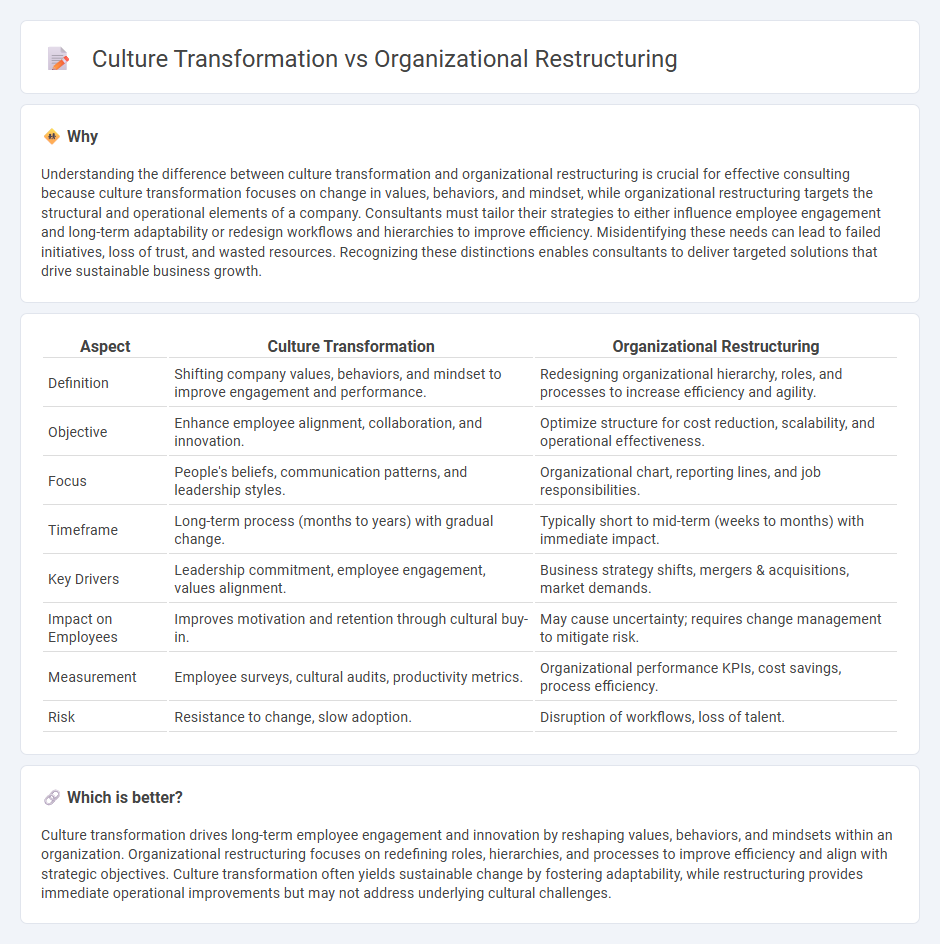
Culture transformation focuses on evolving the underlying values, beliefs, and behaviors to align with strategic goals, fostering sustainable employee engagement and innovation. Organizational restructuring involves redesigning the formal structure, roles, and processes to improve efficiency and adapt to market changes. Discover how integrating these approaches can drive lasting business success.
Why it is important
Understanding the difference between culture transformation and organizational restructuring is crucial for effective consulting because culture transformation focuses on change in values, behaviors, and mindset, while organizational restructuring targets the structural and operational elements of a company. Consultants must tailor their strategies to either influence employee engagement and long-term adaptability or redesign workflows and hierarchies to improve efficiency. Misidentifying these needs can lead to failed initiatives, loss of trust, and wasted resources. Recognizing these distinctions enables consultants to deliver targeted solutions that drive sustainable business growth.
Comparison Table
| Aspect | Culture Transformation | Organizational Restructuring |
|---|---|---|
| Definition | Shifting company values, behaviors, and mindset to improve engagement and performance. | Redesigning organizational hierarchy, roles, and processes to increase efficiency and agility. |
| Objective | Enhance employee alignment, collaboration, and innovation. | Optimize structure for cost reduction, scalability, and operational effectiveness. |
| Focus | People's beliefs, communication patterns, and leadership styles. | Organizational chart, reporting lines, and job responsibilities. |
| Timeframe | Long-term process (months to years) with gradual change. | Typically short to mid-term (weeks to months) with immediate impact. |
| Key Drivers | Leadership commitment, employee engagement, values alignment. | Business strategy shifts, mergers & acquisitions, market demands. |
| Impact on Employees | Improves motivation and retention through cultural buy-in. | May cause uncertainty; requires change management to mitigate risk. |
| Measurement | Employee surveys, cultural audits, productivity metrics. | Organizational performance KPIs, cost savings, process efficiency. |
| Risk | Resistance to change, slow adoption. | Disruption of workflows, loss of talent. |
Which is better?
Culture transformation drives long-term employee engagement and innovation by reshaping values, behaviors, and mindsets within an organization. Organizational restructuring focuses on redefining roles, hierarchies, and processes to improve efficiency and align with strategic objectives. Culture transformation often yields sustainable change by fostering adaptability, while restructuring provides immediate operational improvements but may not address underlying cultural challenges.
Connection
Culture transformation and organizational restructuring are interconnected processes that drive sustainable change within a company. Restructuring realigns organizational frameworks, roles, and workflows, enabling the adoption of new cultural values, behaviors, and mindsets necessary for business agility. Successful consulting strategies leverage this synergy to foster employee engagement, enhance collaboration, and accelerate digital transformation initiatives across complex enterprises.
Key Terms
**Organizational Restructuring:**
Organizational restructuring involves redesigning a company's hierarchy, roles, and processes to improve efficiency and adapt to market changes, often targeting cost reduction and operational agility. This approach prioritizes structural changes such as team realignment, merging departments, or implementing new reporting lines to streamline decision-making and enhance productivity. Explore how strategic restructuring can drive business performance and employee engagement for deeper insights.
Span of Control
Organizational restructuring often targets Span of Control to improve management efficiency by adjusting the number of direct reports per supervisor, which impacts decision-making speed and communication flow. Culture transformation emphasizes modifying shared values and behaviors that influence how managers naturally exercise control beyond formal Span of Control limits. Explore the nuances and strategic impact of these approaches for a deeper understanding of optimizing leadership effectiveness.
Reporting Lines
Organizational restructuring involves changing reporting lines to improve efficiency, clarify roles, and align responsibilities with business goals, often resulting in new hierarchical layers or flatter structures. Culture transformation focuses on shifting employee behaviors, values, and mindsets, influencing how teams collaborate and communicate beyond formal reporting relationships. Explore in-depth how altering reporting lines through restructuring differs from cultivating a culture that supports organizational agility and innovation.
Source and External Links
Organizational Restructuring: Meaning | Process | Examples - Organizational restructuring involves changing an organization's structure or operations to improve efficiency or better align with its goals, often including changes in hierarchy, responsibilities, or departmental organization to respond to market changes, new leadership, or strategic shifts.
Organizational Restructuring: Definition, strategies and top examples - It is a strategic move to realign internal structures, roles, and processes to enhance communication, technological integration, talent optimization, customer centricity, or overall strategic repositioning for improved efficiency and competitiveness.
Organizational Restructuring: 7 Strategies for HR (+ Free Template) - Organizational restructuring is a strategic process to enhance efficiency, adapt to market demands, or improve competitiveness, often triggered by economic pressures, mergers, leadership changes, or continuous improvement needs, involving realignment of departments, roles, and sometimes downsizing to ensure sustainability.
 dowidth.com
dowidth.com